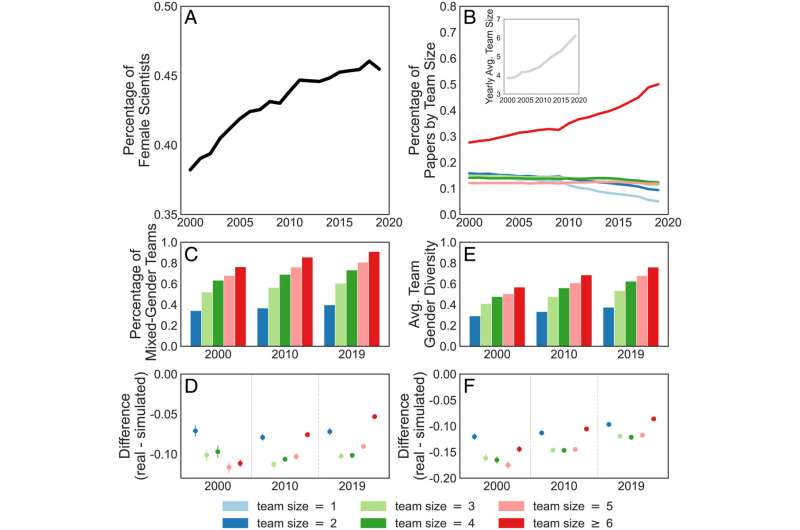The underrepresentation of gender-diverse teams. (A) The sharp upward trend of women’s participation in medical research over the last 20 y. (B) The share of different team sizes by year over the same period. The major change is that large teams of six or more researchers per paper have supplanted teams of smaller sizes with the largest drop in solo authorship and two-person teams. C and D show that the share of publications from mixed-gender teams has steadily increased with time. Nonetheless, E and F indicate that mixed-gender teams are significantly underrepresented in medical science (no CIs cross the 0.00 difference line) by up to 17% depending on the team size when we measure team gender diversity using the Shannon entropy. Credit: Proceedings of the National Academy of Sciences DOI: 10.1073/pnas.2200841119
The number of medical science publications by mixed-gender teams has grown rapidly over the past two decades, but remains underrepresented compared to what would be expected by chance.
New research from the University of Notre Dame examines about 6.6 million papers published across the medical sciences since 2000 and reveals that a team's gender balance is an under-recognized, yet powerful indicator of novel and impactful scientific discoveries.
"Gender-diverse Teams Produce More Novel and Higher Impact Scientific Ideas" is forthcoming in Proceedings of the National Academy of Sciences, from lead author Yang Yang, assistant professor of information technology, analytics and operations at Notre Dame's Mendoza College of Business.
Conducting the first large-scale systemic investigation of the performance of gender-diverse research teams in the medical sciences, the team analyzed research publications by 3.2 million women and 4.4 million men scientists in more than 15,000 medical science journals from 2000 to 2019. Authors in all positions (lead author, second author, etc.) were included, and those who published multiple articles were not counted multiple times.
"We find the publications of mixed-gender teams are substantially more novel and impactful than the publications of same-gender teams of equal size," said Yang, who also studies how social networks and gender affect individuals' success. "And the greater a team's gender balance, the better the performance."
The team finds that advantages of gender-diverse teams hold for small and large teams, all 45 subfields of medicine and women- or men-led teams, and generalize to published papers in all science fields over the last 20 years.
"Our findings reveal potentially new gender and teamwork synergies that correlate with scientific discoveries and inform diversity, equity and inclusion initiatives," Yang said.
The study states that "laboratory experiments suggest that women on a team improve information-sharing processes on teams, such as turn taking. It might also be that women provide a perspective on research questions that men do not possess and vice versa."
Yang also says that "given the noncausal nature of our study, we are conservative in speculating on the theoretical mechanisms, but the richer descriptive findings in such a large-scale dataset are informative and point to a potentially transformative approach for thinking about and capturing the value of gender diversity in science."
The team finds the novelty and impact advantages among mixed-gender teams persist when considering numerous controls, including fixed effects for the individual researchers, team structures and network positioning.
Since last century, Yang says, science has undergone two transformations that may potentially be remaking scientific outcomes.
"One is the shift from individual to team science," he said. "So, increasing teamwork levels are broadly documented in different scientific disciplines. The second has to do with women's participation in science. Many policies have been made to increase women's attendance."
In medicine, women's participation rates have reached the same level of men's over the last decade. However, gender inequalities still exist in science, especially in grants and prizes.
Because gender-diverse teams are still under-represented in medical science, Yang says the study may help speed breakthroughs by breaking down barriers to the formation of gender-diverse teams.
More information: Yang Yang et al, Gender-diverse teams produce more novel and higher-impact scientific ideas, Proceedings of the National Academy of Sciences (2022). DOI: 10.1073/pnas.2200841119
Journal information: Proceedings of the National Academy of Sciences
Provided by University of Notre Dame























